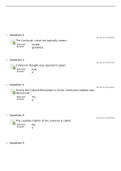Samenvatting
Summary of the whole course Management Accounting 1 for business (6012B0421). Everything you need to know for the exam including descriptions of calculations
- Instelling
- Universiteit Van Amsterdam (UvA)
FULL summary of everything you need to know for the Management Accounting 1 for business (6012B0421) FINAL exam, including specific descriptions of the calculations. Everything is clearly explained with colorful indications of what to add to what and why the result is like that. This summary is all...
[Meer zien]














